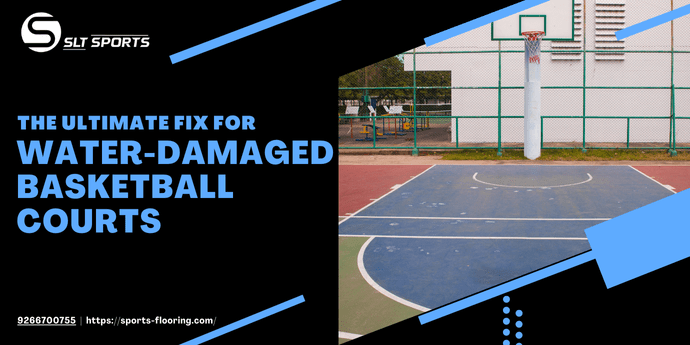
India’s varying weather, with its pounding monsoon rains and scorching summer heat, makes the upkeep of a basketball court surface quite tricky. Over the last ten years, SLT Sports has handled countless outdoor basketball court flooring projects. These have ranged from large professional complexes to simple backyard basketball court flooring setups. A common issue they often face is dealing with water seepage in basketball court.
Water getting into your court does more than just wear it down. It harms safety, lowers play quality, and cuts down how long the court lasts. Slippery spots raise the chance of injuries, and moisture stuck below can lead to blistering, cracks, or peeling on your basketball court surfaces. Ignoring the issue can result in expensive structural fixes or even replacing the whole court.
We have learned through experience that two things play a major role in stopping these issues: building courts with good drainage in the beginning and keeping up with regular skilled maintenance. This blog will explain why managing drainage acts as the first layer of protection for your court, how water leakage harms outdoor sports flooring, the specific repair methods we use on-site, and the most trusted outdoor basketball surfaces to ensure durability. These aren’t just random tips. They come from years of on-the-ground work by our team of expert basketball court builders and engineers who understand how India’s climate impacts sports flooring over time.
Why Good Basketball Court Construction and Drainage Are Important
One of the costliest and most frequent errors in basketball floor installation happens when drainage isn’t planned properly. Court owners often notice issues too late, like puddles forming or surface coatings peeling. At that point, fixing the problem costs much more than it would have to prevent it during the building process.
To address this from an engineering standpoint, it is essential to design a proper slope that lets rainwater drain off the court . This step is a must to handle outdoor basketball court flooring in places with heavy monsoon seasons. In regions with a lot of rain, we also use channel or perimeter drains to move water away from the edges and base of the court.
Choosing the right materials for the base is just as important. At SLT Sports, we suggest using a compacted layer of crushed stone as the foundation covered with either asphalt or reinforced concrete. This setup prevents water from seeping through. High-quality sealants are applied to expansion joints to keep water out. These small details might not seem like a big deal, but our research shows they can increase a court’s lifespan by 30–40% compared to ones built without these features.
When you think about the outdoor basketball court flooring cost, it’s important to keep this in mind. Building a court with good drainage is an investment that avoids years of costly repairs. To build durable courts in India’s challenging weather, you need to work with expert basketball flooring companies. This applies to both home basketball court flooring and larger sports facilities.
How Water Seepage Ruins Basketball Courts
During our inspections, we noticed how outdoor basketball court surfaces tend to fail without much warning. Small bubbles or blisters are the first signs. These form when moisture gets stuck under the acrylic layer. Over time, they grow larger, peel away, and expose the base underneath. In colder regions, freezing water in the base layer expands and causes cracks that get worse with each passing winter. In hot areas constant moisture speeds up the coating’s wear-and-tear dulling the colors and making the surface less grippy.
A slippery basketball court surface poses a safety hazard. To play on backyard basketball court flooring, families risk injuries when the surface isn’t reliable. On school or professional courts, this could lead to canceled games or affect how players perform.
The main reasons behind the damage are different. Poor slope layouts blocked drains, and long-neglected cracks often lead to major issues. Maintenance teams have seen that the worst problems show up on courts missing a solid drainage system. Taking care of basic tasks like clearing out drainage pathways matters as much as the quality of the basketball floor installation itself. It does not matter if your outdoor basketball court surfaces prices show a high-end design or a cheaper option. Water seepage is a problem for all courts unless handled the right way.
Fixing Basketball Court Seepage: How to Do It
When you repair a basketball court damaged by water, start with getting rid of the water and drying the area. Industrial squeegees, large blowers, and sometimes wet vacuums help make sure no water stays on the basketball surface or in dips.
After that, clean the court using a solution made just for that type of surface. Harsh chemicals are avoided. To rinse it, use a water hose with gentle pressure to avoid harming the current coatings.
After cleaning and drying the surface, check it closely to find cracks, holes, or uneven spots. Filling the basketball court cracks with a concrete patching compound seal entry points and brings back the surface’s strength. Once the basketball flooring material sets, smooth out the area by spreading an acrylic resurfacer. Then add a high-quality acrylic topcoat to improve the look and block moisture.
Repaint the basketball court lines after that using professional coatings made for basketball courts. For anyone wanting to add durability, we suggest trying cushioned acrylic systems or modular tile surfaces. This holds up much better against moisture problems over time.
Stopping future water seepage is always a priority.
At SLT Sports, we remind clients that avoiding problems costs much less than fixing them . Catching damage needs regular checks, and doing this every few months works best. Drains must stay clear since one blockage can cause water to collect and leak in specific areas.
Deep cleaning is crucial when seasons change right before or after monsoons, to keep outdoor basketball court flooring in good shape. We suggest reapplying acrylic sealant every few years to refresh the layer that protects the surface. In places with heavy rain, putting removable covers over courts during storms can prevent expensive fixes later.
Simple things like not dragging equipment can protect sealants and keep the basketball surface intact. With the cost of outdoor basketball court surfaces, these small actions can add years to the court’s lifespan. Working with trusted basketball flooring companies like SLT Sports to perform annual upkeep helps ensure the court remains safe, functional, and good-looking.
Conclusion
Water damage is both easy to avoid and one of the worst issues for basketball court flooring. Over the last 10+ years, by building and fixing outdoor sport court flooring all across India, we’ve seen that the best results come from good basketball court construction, regular fixes, and stopping problems .
Starting with proper construction and ensuring effective drainage, every detail plays a role. Steps like draining water, drying the area, applying a surface-specific cleaning solution, and using concrete patch compounds to fix cracks are all crucial.
SLT Sports goes beyond just setting up courts. Our sports flooring materials handle India’s tough weather conditions. Whether you are starting a home basketball flooring project or fixing up an outdoor professional court, our skilled basketball court installers combine safety, performance, and longevity in every job.
A well-planned approach keeps your court ready for sports, exercise, and community gatherings in any weather.
Frequently Asked Questions
Water seepage is usually caused by poor drainage, cracks in the surface, or moisture rising from the ground.
Water seepage weakens the sub-base, causes surface bubbles, warping, and cracks, and reduces the overall grip and bounce of the court.
It is recommended to inspect courts at least twice a year before and after the monsoon season to catch early signs and avoid costly repairs.
Sealing cracks helps prevent moisture, but for long-term results, sealing should be combined with waterproof coatings and proper drainage improvements.

